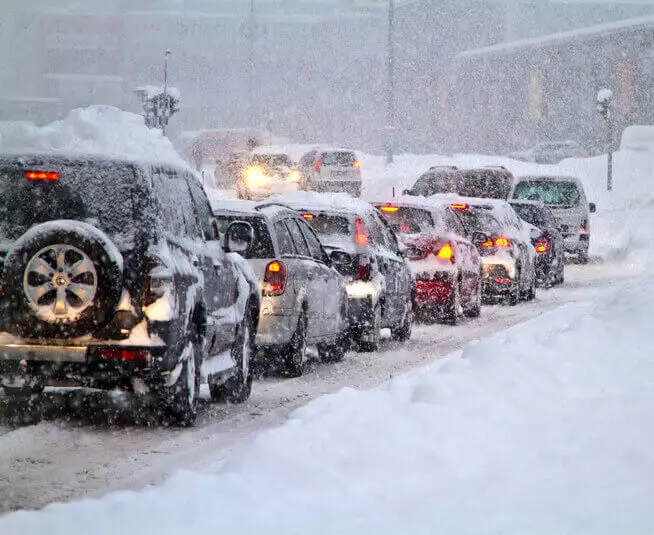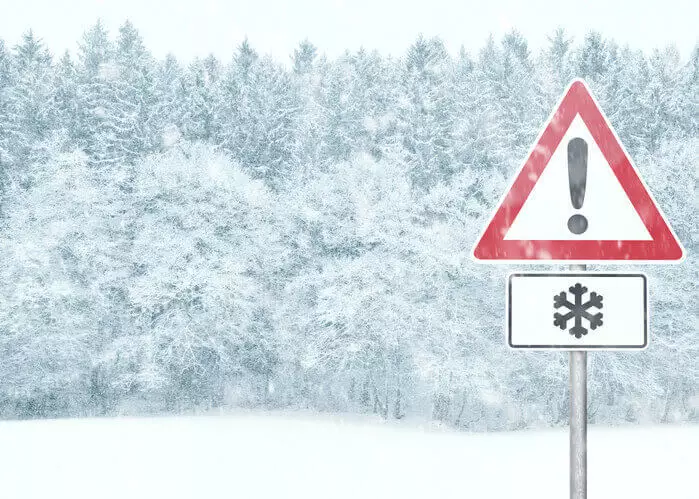Driving in winter weather can be challenging, to say the least. But with a little bit of preparation and know-how, it doesn’t have to be dangerous. In this blog post, we will explore some winter weather driving tips to help you stay safe on the roads. From properly preparing your vehicle to knowing how to respond in case of an emergency, here are some valuable tips for driving in snow that everyone should be aware of.

Winter Car Maintenance Routine
As the temperatures start to drop and winter weather sets in, it's important to make sure your car is up for the challenge. One of the best winter driving tips anyone can offer is in regard to simple car maintenance. Here's a very basic winter car maintenance routine from your friends at GoodCar to help keep your car running smoothly all season long:
1. Check Your Tires
Make sure your tires are properly inflated and have enough tread to grip the road in icy or snowy conditions. If you're not sure, ask a professional at your local tire shop.
2. Get a Tune-Up
A tune-up can help improve your car's fuel efficiency and make sure all the engine's systems are running smoothly. This is especially important in cold weather when your car's engine has to work harder.
3. Change Your Oil
If you haven't already, switch to a winter-grade oil that won't thicken and clog up your engine in cold weather. You should also get an oil change more frequently in winter since you're likely driving less overall.
4. Inspect Your Battery
A dead battery is one of the most common reasons for cars not starting in winter, so it's important to get it checked before the season starts, which is why it is one of the top winter driving safety tips. Many auto shops offer free battery tests so you can be sure yours is up for the task.
Before You Start Driving In Snow
Before you start driving in winter weather, there are a few things you should do to prepare. First, check the weather forecast and plan your route accordingly. If possible, avoid traveling during heavy snow or ice storms. If you must travel, make sure you have a full tank of gas and allow extra time to reach your destination.
Next, take some time to clear the snow and ice from your vehicle. This includes the hood, windshield, windows, headlights, taillights, and mirrors. Be sure to use a brush or scraper specifically designed for removing ice; never use hot water, which can crack your windshield.
Once you’re on the road, drive slowly and allow extra space between your vehicle and the one in front of you. Use your headlights (low beams are best) and give yourself plenty of time to brake. If you do start to skid, avoid slamming on the brakes; instead, gently ease off the accelerator until you regain control.
Finally, while driving in winter weather, be sure to go slowly and give yourself plenty of space between you and the car in front of you. Braking distances increase on wet or icy roads, so it's important to give yourself plenty of time to stop. Also be aware of black ice, which can form on bridges and overpasses. And finally, don't forget to signal when turning or changing lanes!

How To Drive In Snow During Your Drive
When you're driving in winter weather, it's important to take extra care. Here are some tips to help you stay safe:
- Slow down and allow yourself extra time to get to your destination.
- Use the 3 second rule for safe following distance.
- Be extra cautious on bridges and overpasses, which can freeze before other parts of the road.
- Use your headlights so that you can see and be seen by other drivers.
- Don't use cruise control, as it can be more difficult to regain control of your car if you start to slide on the ice.
- Keep an emergency kit in your car including items like a shovel, blankets, and snacks.
After You Arrive at Your Destination
After you arrive at your destination, there are a few things you can do to ensure your safety. First, if possible, stay in your car until the storm passes. This will give you the best chance of not getting stranded or lost in the storm. If you must leave your car, be sure to let someone know where you are going and when you expect to return.
Second, be aware of your surroundings and pay attention to the weather conditions. If the wind is blowing snow around, it can create conditions that make it difficult to see. Be careful when walking and driving in these conditions.
Finally, stay hydrated and dress warmly. It is important to stay warm in cold weather, so dress in layers and keep yourself covered. Drink plenty of fluids to avoid dehydration, which can worsen the effects of cold weather on your body.
Winter Car Safety Tips
With winter weather comes icy roads, snow drifts, and decreased visibility. Here are a few tips to help you stay safe on the roads this winter:
- Before hitting the road, clear all ice and snow from your car - this includes your windows, windshield, roof, and lights.
- Increase your following distance from the car in front of you. It takes longer to stop on icy roads.
- Drive slower than the posted speed limit.
- Use your low-beam headlights when driving in fog or falling snow. High beams will reflect off the flakes and actually decrease your visibility.
- Watch out for black ice - it can be hard to see and is often found on bridges or overpasses where the sun doesn't hit as directly.
- Don't use cruise control in winter weather conditions - it's harder to maintain control of your car if you're not actively pressing the gas pedal.
- Keep an emergency kit in your trunk including blankets, non-perishable food items, a first-aid kit, flares, and a shovel.
Winter Driving Gear
If you live in an area where winter weather conditions are common, it's important to make sure you have the right gear in your car. Here are some items you should keep in your car during the winter:
- A snow brush and ice scraper: You'll need these to clear your windshield and windows of snow and ice.
- A set of jumper cables: If your battery dies, jumper cables will help you get it started again.
- A bag of sand or cat litter: This can be used to help give your tires traction if you get stuck in the snow.
- A first aid kit: In case of any car accidents, it's always good to have a first aid kit on hand.
- Blankets and warm clothing: If you get stranded, these will help keep you warm until help arrives.
- A flashlight: A flashlight can be used for signaling for help or for seeing in the dark.
- A cell phone charger: This will come in handy if your cell phone battery dies and you need to call for help.
To find out more about the best way to drive in the snow or find a vehicle that is better suited to tackle the icy mess we’re going to be facing, check out GoodCar today!








![Best Sites to Check a Car’s History [2025 Review]](https://media.infopay.net/thumbnails/K8lMeG2QLjE46LPqZlmoi6SunKKdT5qvlaRZk6e1.webp)










![Best Sites to Check a Car’s History [2025 Review]](https://media.infopay.net/thumbnails/K8lMeG2QLjE46LPqZlmoi6SunKKdT5qvlaRZk6e1-w356.webp)
